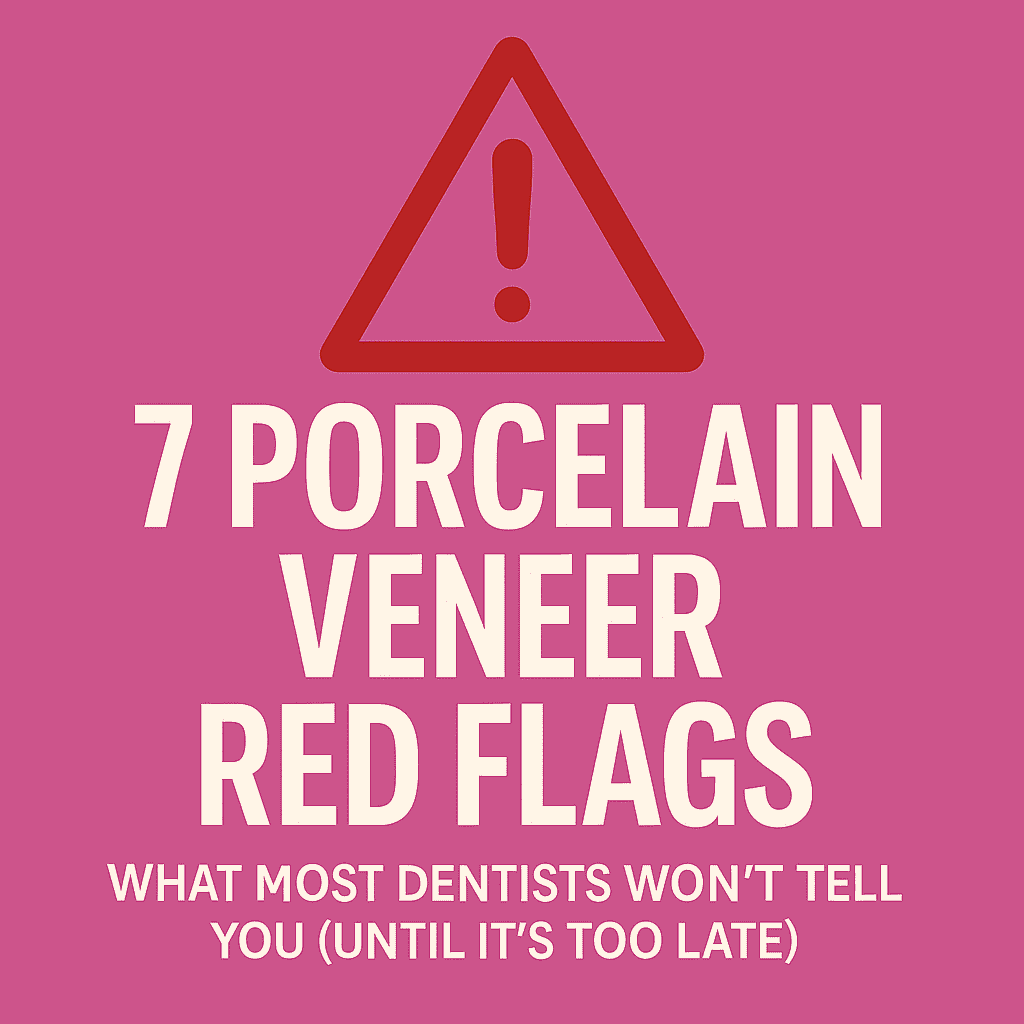Introduction
Thinking about getting porcelain veneers? This quick but thorough guide breaks down the biggest red flags that people often find out after it’s too late.
Whether you’re already booked for a consult or just starting your research, this is the transparency most people wish they got before shaving their teeth.

This guide is designed to give you clear, confident control—no jargon—before you make one of the biggest cosmetic choices of your life. Let’s get started: 7 Porcelain Veneer Red Flags Most Dentists Won’t Mention (Until It’s Too Late).
1. “No-Prep” ≠ No Damage
Many dentists claim no-prep veneers are reversible, but they often aren’t. Even “minimal prep” veneers can involve etching or shaving enamel—and once it’s gone, it’s permanent. Small changes to your natural teeth can lead to long-term health and bite issues.

Quick Tip: Only 5–15% of people are true candidates for no-prep veneers. Many are steered into “minimal prep” instead, which still involves altering your teeth. Be wary of this bait-and-switch tactic—once you begin, there’s no going back.
2. The Subscription Model Nobody Talks About
Veneers last about 10–15 years, turning your smile into a high-cost subscription. In the U.S., each veneer ranges from $2,000–$3,500. Most people veneer 8 upper front teeth, totaling $16,000–$28,000. Over a lifetime, with replacements, you could spend $75,000+.
Quick Tip: Avoid porcelain veneers for purely aesthetic reasons if you’re under 65. The financial and biological trade-offs may not be worth it. Celebrities can afford multiple replacements.
For most people, the emotional and financial toll adds up fast. Consider whitening, orthodontics, or enhanced composite bonding as safer, more flexible alternatives.
3. Bonding Agents May Contain BPA or Endocrine Disruptors
Some bonding agents contain BPA or related compounds—potential hormone disruptors absorbed through soft tissue.
While long-term studies are lacking, many experts recommend caution. Industry-funded trials are unlikely due to potential business impact.
Quick Tip: Ask your dentist exactly what bonding materials they use—and whether they’re BPA-free. If they dodge the question, that’s a red flag.
4. The Smile Template Trap
Some dentists use AI-generated or template-based smile designs that ignore your individual face shape. In the past, natural celebrity smiles (like Halle Berry’s or George Clooney’s) were the standard. Now, one-size-fits-all veneers are replacing individuality with symmetry

Rushed or Mismatched Veneers = Corrective Treatment
Poor design or rushed treatment can lead to bulky, unnatural veneers that affect bite and comfort. Some patients need full replacements due to poor work.
Quick Tip: Ask who is making your veneers. Is it a master ceramist or a basic lab? You have a right to know who’s crafting your smile.
5. Insurance Won’t Save You
In the U.S., insurance doesn’t cover veneers for aesthetic reasons. Even when some coverage exists, most dentists won’t bill due to the headache of audits and paperwork. If something goes wrong—you’re on your own.
Quick Tip: You can’t sue easily for cosmetic work. Since veneers are elective and often paid in cash, legal protection is limited. Know what you’re committing to.
6. Composite vs. Porcelain Isn’t Just About Cost
Porcelain is durable and long-lasting—but requires permanent enamel removal and costs more.
Veneers are lab-made and bonded to the front (often wrapping underneath), permanently changing your natural teeth

Traditional bonding (composite veneers) is done chairside, is cheaper, and less invasive—but only lasts 5–8 years and stains more easily.
Enhanced Composite Bonding is a newer, high-end option. It uses layered, sculpted composite applied directly by a skilled dentist. It looks natural, is easy to repair, and can last 20–25+ years with proper care. Best of all—it’s completely noninvasive and reversible.
Quick Tip: Some dentists claim to offer enhanced bonding but actually use basic composite. Ask detailed questions about their technique and materials.
7. You May Lose Your Natural Bite Forever
Shaving teeth alters your bite and jaw forever. This can cause clenching, TMJ strain, headaches, and even lisps. Many patients also experience cold sensitivity.
Porcelain is harder than enamel, which can cause premature wear on lower teeth—especially if you grind or clench.
Quick Tip: If your teeth are healthy or even moderately healthy, veneers can make them look and feel less natural. Think twice before altering them for cosmetic reasons.
The Bottom Line
Porcelain veneers are often presented as a quick fix for a perfect smile, but the reality includes serious tradeoffs. From irreversible enamel loss to long-term maintenance costs and potential health concerns, the risks are real and often underplayed.
Before moving forward, take time to explore safer and reversible alternatives and ask detailed questions. Your natural teeth deserve careful consideration, not pressure or regret.

Disclaimer: This content is for informational purposes only and does not constitute medical or dental advice. Please consult a licensed dental professional before making any treatment decisions.
We have included cosmetic dentist Dr. Jordan Davis in this post because his work reflects the kind of care we believe in. He focuses on no drilling and ultra conservative smile enhancements that protect your natural teeth. We are not affiliated with him and do not speak on his behalf, but we have followed his work closely and truly respect what he is doing.
If you are considering a smile enhancement and want guidance from a team that understands the process, feel free to reach out using the form below. We are always happy to help however we can.
We cannot guarantee pricing, but in some cases, members of our community have received preferred rates or flexible options through these connections.





